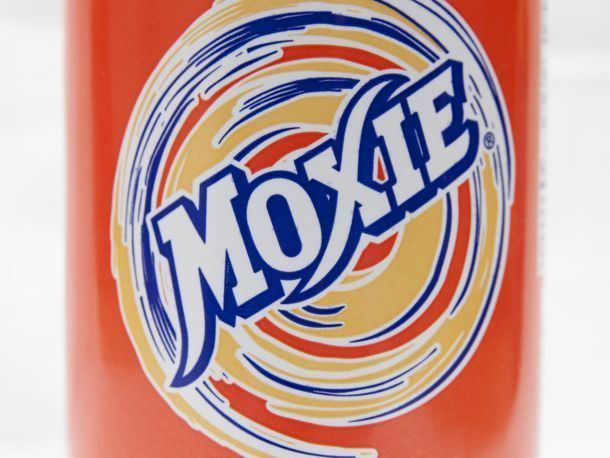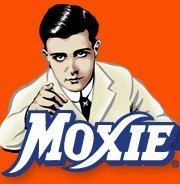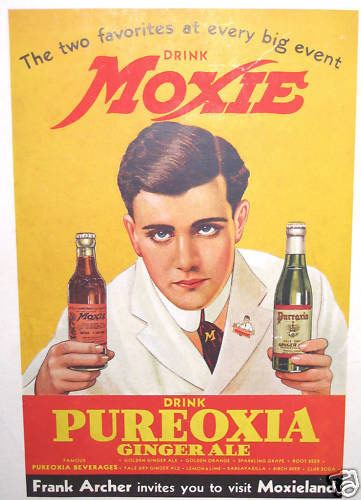Country of origin United States Color Caramel | Introduced 1876 | |
 | ||
Manufacturer Cornucopia Beverages/Moxie Beverage Company(Kirin Holdings Company) Discontinued Moxie Cherry Cola, Moxie Cream Soda, Moxie Orange Cream, Ted's Root Beer Variants Diet Moxie, Moxie Energy, Moxie Energy Citrus, Moxie Energy Explosion, Moxie Energy Thunder, Olde New England Seltzer, Moxie Blue Cream | ||
Moxie with sugar review soda tasting 39
Moxie is a brand of carbonated beverage that was among the first mass-produced soft drinks in the United States. It continues to be regionally popular today. It is produced by the Moxie Beverage Company of Bedford, New Hampshire, which (through several levels of wholly owned subsidiaries) is part of the Kirin Holdings Company of Tokyo, Japan. As a result of widespread brand advertising, the brand name has become the word "moxie" in the English language, meaning "courage, daring, or spirit".
Contents
- Moxie with sugar review soda tasting 39
- Moxie soda store clerk from lisbon falls maine
- History
- Since 1962
- Advertising
- Popular culture
- Derivative products
- References

Moxie's flavor is unique, as it is not as sweet as most modern soft drinks and is described by some as bitter. Moxie is flavored with gentian root extract, an extremely bitter substance which was reputed to possess medicinal properties. It originated around 1876 as a patent medicine called "Moxie Nerve Food".

Moxie is closely associated with the state of Maine and was designated the official soft drink of Maine on May 10, 2005. Its creator, Dr. Augustin Thompson, was born in Union, Maine, but Moxie was created and first produced in Lowell, Massachusetts.

Moxie soda store clerk from lisbon falls maine
History

Moxie originated as a patent medicine called "Moxie Nerve Food", which was created around 1876 by Dr. Augustin Thompson in Lowell, Massachusetts. Thompson claimed that it contained an extract from a rare, unnamed South American plant, which is now known to be gentian root. Moxie, he claimed, was especially effective against "paralysis, softening of the brain, nervousness, and insomnia".

Thompson claimed that he named the beverage after a Lieutenant Moxie, a purported friend of his, who he claimed had discovered the plant and used it as a panacea, and the company he created continued to promulgate legendary stories about the word's origin. It likely derives from an Abenaki word that means "dark water" and which is found in lake and river names in Maine, where Thompson was born and raised.
After a few years, Thompson added soda water to the formula and changed the product's name to "Beverage Moxie Nerve Food". By 1884 he was selling Moxie both in bottles and in bulk as a soda fountain syrup. In 1885, he received a trade mark for the term. He marketed it as "a delicious blend of bitter and sweet, a drink to satisfy everyone's taste". Thompson died in 1903.
A lawsuit was filed in 1907 by the Moxie Nerve Food Company of New England against the Modox Company and others, alleging that they had copied the ingredients of Moxie and were using the name "Modox", which closely resembled "Moxie", and were infringing upon patents and trademarks. The suit was dismissed by the judge, who said the court could not protect the legitimate part of the plaintiff's business in this case. In a later case in New York, the Moxie Nerve Food Company won a lawsuit against Modox, which subsequently went out of business.
President Calvin Coolidge was known to favor the drink, and Boston Red Sox slugger Ted Williams endorsed it on radio and in print. The company also marketed a beverage called "Ted's Root Beer" in the early sixties. Author E. B. White once claimed that "Moxie contains gentian root, which is the path to the good life." Currently, one of the ingredients of Moxie is "Gentian Root Extractives", which may contribute to the drink's unique flavor.
The brand suffered a significant decline in sales during the 1930s, which is thought to have been caused by the company's decision to expand its sugar reserves at the expense of its popular advertising campaign.
An alternative explanation for the company's decline in sales was that soda fountain operators (also called soda jerks) would give extra blasts of the syrup into the glass before adding the soda water. As Moxie was not as sweet as Coke or Dr. Pepper, this would not produce as delicious a refreshment.
The Catawissa Bottling Company in Catawissa, Pennsylvania, is one of six bottlers in the United States that produce Moxie. Catawissa has produced it since 1945. Polar Beverages also bottles Moxie in Worcester, Massachusetts, as does Orca Beverage in Mukilteo, Washington.
Since 1962
Sugar-free Diet Moxie was introduced in 1962, about the same time that Mad magazine began placing the Moxie logo in the background of its articles to increase public awareness of it. As a result of Mad ’s efforts, sales of the soft drink increased 10%; this led to the "Mad About Moxie" campaign.
The Moxie brand was purchased in 1966 by the Monarch Beverage Company of Atlanta. In 2007 Monarch sold it to its current owner, Cornucopia Beverages of Bedford, New Hampshire, which is owned by the Coca-Cola Bottling Company of Northern New England, a subsidiary of the Kirin Brewery Company, which is a subsidiary of Kirin Company, Limited, which is a subsidiary of Kirin Holdings Company, Limited, based in Tokyo, Japan (a member of the Mitsubishi keiretsu).
In its decision to step up efforts to distribute the product, Cornucopia cited increasing requests for Moxie from fans across the country. In 2007 it launched pilot sales in Florida and in 2010 granted distribution in Florida to Florida Micro Beverage Distributors.
In 2011 Cornucopia began doing business as the Moxie Beverage Company to market Moxie and Moxie-branded products. A website, DrinkMoxie.com, was created to promote Moxie. Drink recipes using Moxie were created.
Demand for Moxie has waned in recent years, although the brand persists in New England and Pennsylvania.
Advertising
Through extensive advertising, the neologism "moxie" has entered popular American usage with the meaning "courage, daring, or spirit", as in "This guy's got moxie!"
In its advertising, Moxie used "Make Mine Moxie!" advertising jingles, the slogan "Just Make It Moxie for Mine", and a "Moxie Man" logo. The Moxie Man had appeared on Moxie labels since the beverage was first sold. But in 2010 the Moxie Man logo was removed from labels because it was thought to be too old-fashioned. In 2011 the company's head of marketing, Ryan Savage, made the executive decision to bring the logo back in response to complaints from long-standing customers.
A unique advertising tool was the Moxie Horsemobile, a modified automobile whose driver sat on a large model of a horse. The first Horsemobiles were deployed around 1918. A 1935 Rolls-Royce Moxie Horsemobile was sold for $55,000 at the May 20, 2011, Mecum Auction in Indianapolis, Indiana. Moxie at one time maintained about two dozen of them, and they appeared in parades and other public functions.
Popular culture
Derivative products
There is also a Moxie Energy Drink and a variety of "Olde New England Seltzers." The energy drink is citrus-based; it lacks Moxie's gentian root tang, caramel color, and (as of 2008) its distinctive branding; similarly, the waters are simply carbonated waters with fruit flavors marketed under the Moxie brand.
Moxie ice cream is also seasonally available in Maine in limited quantities and is mild in flavor as compared to the soft drink.
